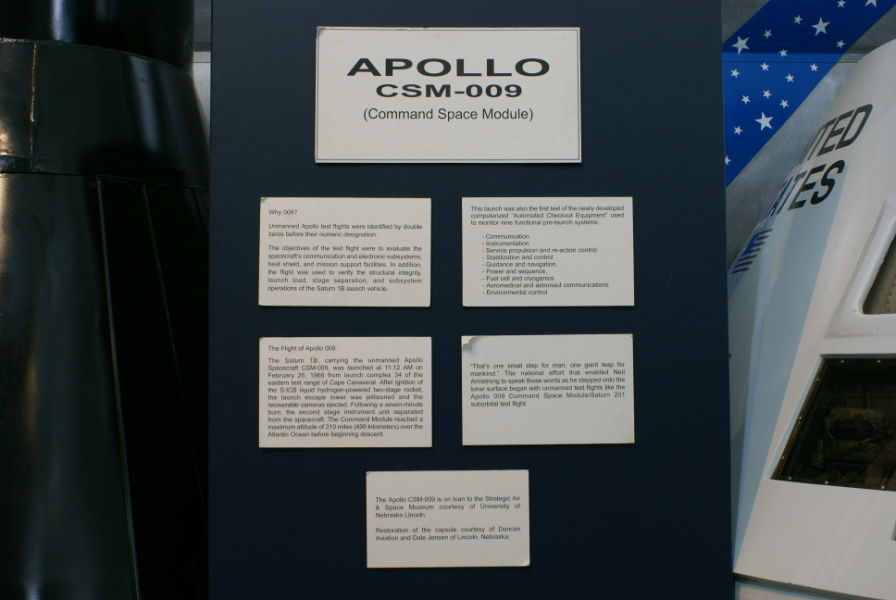| Prev |
heroicrelics.org Strategic Air Command & Aerospace Museum Site Index CM-009 Gallery |
Next |
dsc44253.jpg
The sign next to the command module.
APOLLO
CSM-009
(Command Space Module)
Why 009?
Unmanned Apollo test flights were identified by double zeros before their numeric designation.
The objectives of the test flight were to evaluate the spacecraft's communications and electronic subsystems, heat shield, and mission support facilities. In addition, the flight was used to verify the structural integrity, launch load, stage separation, and subsystem operations of the Saturn IB launch vehicle.
This launch was also the first test of the newly developed computerized "Automated Checkout Equipment" used to monitor nine functional pre-launch systems:
- Communication
- Instrumentation
- Service propulsion and re-action control
- Stabilization and control
- Guidance and navigation
- Power and sequence
- Fuel cell and cryogenics
- Aeromedical and astronaut communications
- Environmental control
The Flight of Apollo 009
The Saturn IB, carrying the unmanned Apollo Spacecraft CSM-009, was launched at 11:12 AM on February 26, 1966 from launch complex 34 of the eastern test range of Cape Canaveral. After ignition of the S-IVB liquid hydrogen-powered two-stage rocket, the launch escape tower was jettisoned and the recoverable cameras ejected. Following a seven-minute burn, the second stage instrument unit separated from the spacecraft. The Command Module reached a maximum altitude of 310 miles (499 kilometers) over the Atlantic Ocean before beginning descent.
"That's one small step for man, one giant leap for mankind." The national effort that enabled Neil Armstrong to speak those words as he stepped onto the lunar surface began with unmanned test flights like the Apollo 009 Command Space Module/Saturn 201 suborbital test flight.
The Apollo CSM-009 is on loan to the Strategic Air & Space Museum courtesy of the University of Nebraska Lincoln.
Restoration of the capsule courtesy of Duncan Aviation and Dale Jensen of Lincoln, Nebraska.

| Time picture taken | Sun Jul 27 10:06:54 2008 |
| Location picture taken |
Hangar B Strategic Air & Space Museum Ashland, NE |
| Prev |
heroicrelics.org Strategic Air Command & Aerospace Museum Site Index CM-009 Gallery |
Next |